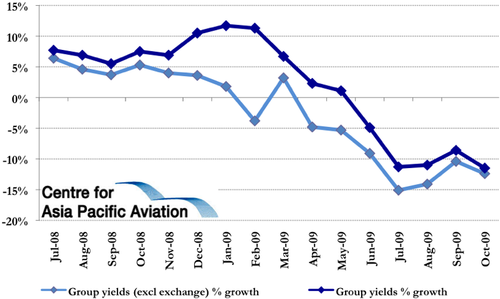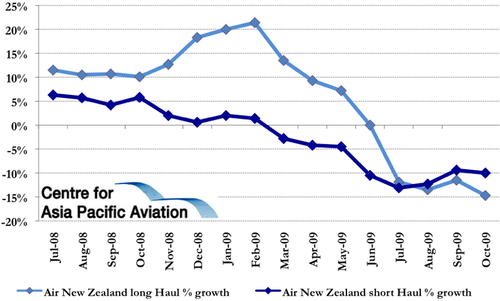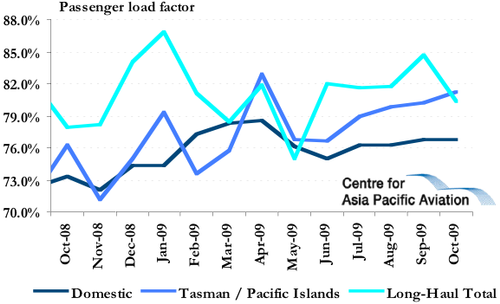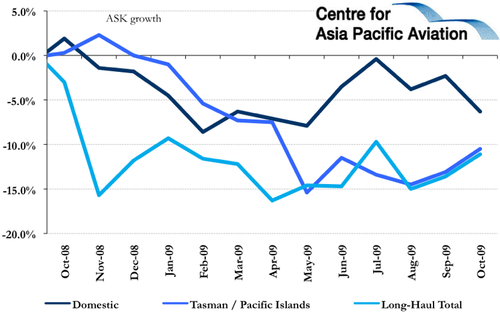Air New Zealand yields continue to suffer in Oct-2009
Air New Zealand's yields continued to suffer in Oct-2009, with Group yields down 11.5% in the month and yields, excluding exchange rate effects, falling 12.4%. This represents a worsening from Sep-2009 levels - Group yields were down 8.6% and ex-exchange effects yields down 10.4% in Sep-2009 - and partly reflects New Zealand's Spring School Holiday Period falling between 26-Sep-2009 and 11-Oct-2009.
Air New Zealand Group yields including and excluding exchange rate effects (% change year-on-year): Oct-2008 to Oct-2009
Double-digit long-haul and short-haul yield reductions
Air New Zealand's long-haul yields continued to take a hammering last month falling 14.7%, following contractions of 11.5% and 13.5% in the previous two months, respectively. Short-haul yields remain under pressure following Jetstar's entry in the domestic market, falling 10.0% in the month.
Air New Zealand short- vs long haul yields (% change year-on-year): Oct-2008 to Oct-2009
Load factors up for third consecutive month in Oct-2009
In more positive news, Air New Zealand's load factors were up in the month, gaining 3.0 ppts, as the carrier reduced capacity (ASKs) by 10.3%, for three consecutive months of load factor improvements, and aided by a 5,0 ppt improvement in Tasman/Pacific load factors. Prior to this, the carrier experienced a double blow of sharp yield contractions and declining load factors.
Air New Zealand passenger load factors (%): Oct-2008 to Oct-2009
In Oct-2009, Air New Zealand transported 931,000 passengers, a 4.1% reduction, as short-haul passenger numbers decreased by 3.3 % and long haul passenger numbers slumped 9.1% (although this was an improvement from the previous month's 10.7% reduction).
Air New Zealand Passenger numbers growth: Oct-2008 to Oct-2009
Tasman a "very tough market"
The carrier reduced capacity (ASKs) on Tasman/Pacific routes by 10.5%, with demand (RPKs) down by 4.5%, resulting in a 5.0 ppt load factor increase to 81.2%.
Air New Zealand capacity (ASKs) growth (%): Oct-2008 to Oct-2009
Air New Zealand Deputy CEO, Norm Thompson, earlier this month, however, stated that while load factors on Tasman services are high and volumes are "really strong", yields remain under intense pressure as excess capacity continues to negatively effect profitability.
Mr Thompson added, "the market is continuing to grow but it's a matter of price. The yields are very poor. But the Tasman is an important market for us, it's our largest international market, and we'll continue to work hard at it… at the moment the market is awash with capacity. There are nine carriers on the route. It is a very tough market".
Signs of improvement on North America/UK routes; Asia region remains "challenging"
Internationally, the carrier stated load factors on North America/UK routes showed signs of improvement, up 3.5% following a 6.3% capacity (ASKs) reduction.
Conditions, however, remain "challenging" in the Asia region, according to Air New Zealand, with demand (RPKs) down 16.3%. The carrier reduced capacity (ASKs) by 17.2% on these services, resulted in an improved load factor (+0.9 ppts) to 78.3%.
More yield pressure ahead, as unsustainable competition intensifies
Load factor improvements aside, intense yield pressures are expected to remain, as Air New Zealand continues to experience yield and demand pressures, due to the global economic crisis.
These pressures have been further exacerbated as Qantas/Jetstar continues its aggressive push on the Tasman and in domestic New Zealand markets and as Pacific Blue continues to fight to grow its presence domestically and internationally.
This situation has prompted Air New Zealand CEO, Rob Fyfe, to previously state that he believes the current New Zealand domestic market with three players in unstable, with the biggest challenge in the market being to adapt to this scenario.
In reaction to this competitive pressure, Air New Zealand, on 16-Oct-2009, reduced its domestic airfares by up to 23%, while also simplifying its fare structures. While this will stimulate demand and load factors and place increased pressure on Air New Zealand's competitors, it means Air New Zealand could be heading for another month of high single-digit or low double-digit yield reductions in Nov-2009.




